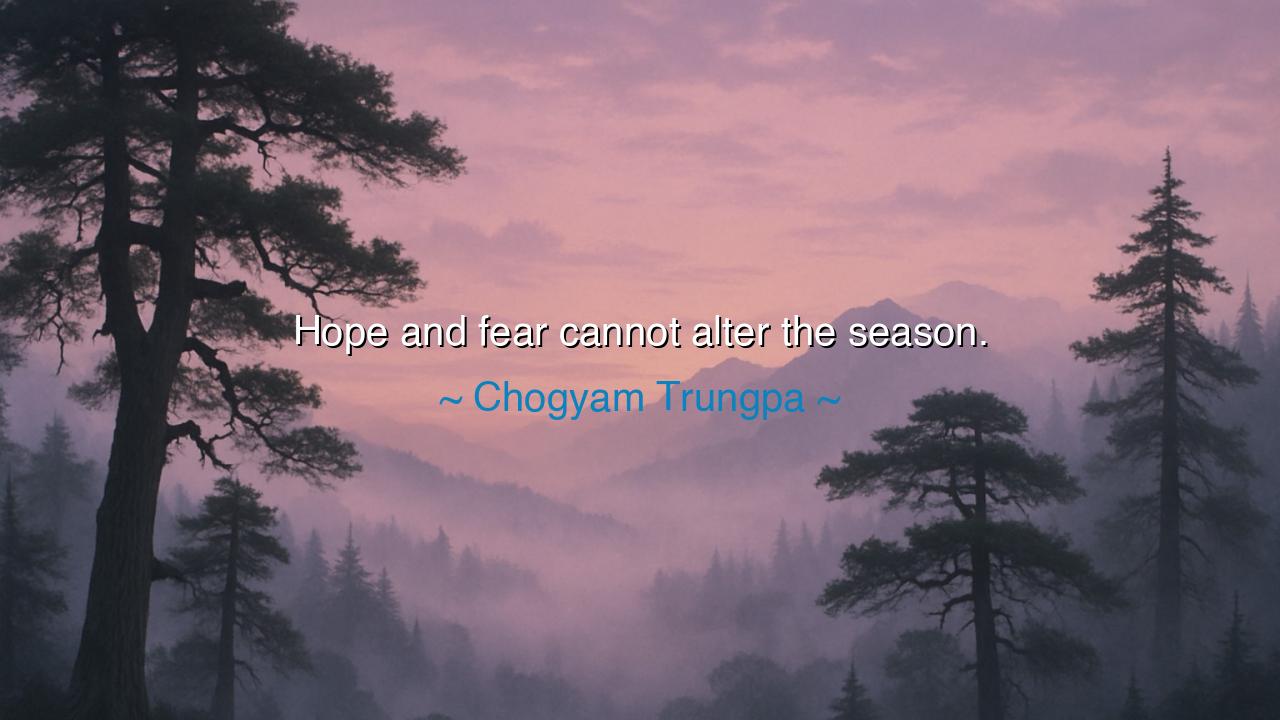
Hope and fear cannot alter the season.






“Hope and fear cannot alter the season.” So spoke Chögyam Trungpa, the Tibetan sage who crossed mountains of both ice and illusion. In these few words lies a universe of calm understanding. The season is the natural order of things—the great cycle that moves beyond the reach of our trembling hearts. The winds will blow when they must, and the snows will melt when their time comes. Whether we dance with joy or weep with despair, the rivers still find their way to the sea. This teaching is not a denial of feeling—it is a reminder of the ancient rhythm that carries all beings, unmoved by our grasping for control.
In the ancient lands of Tibet, the people watched the mountains to read the year’s fate. They knew that no chant, no offering, could summon spring before winter had finished its long dream. Trungpa’s words echo that same wisdom: that hope, though noble, and fear, though natural, cannot command the flow of time. The human heart is restless, forever leaning forward or flinching back. Yet the seasons, eternal and patient, do not heed our wishes. They are teachers, reminding us to yield to what is real and unchanging beneath our fleeting moods.
Consider the story of Marcus Aurelius, the philosopher-king of Rome. When plague swept his empire, he did not curse the heavens or beg for mercy. He wrote instead: “Accept whatever comes to you woven in the pattern of your destiny.” He ruled with calm amid the storm, knowing that neither hope for a swift end nor fear of ruin could alter the law of nature. His acceptance was not weakness—it was strength, drawn from understanding. Like Trungpa’s insight, it was a call to stand still within the storm and see clearly that the storm itself is passing, as all storms do.
When we chase hope, we often mistake it for control. We believe that if we wish hard enough, we can force the sun to rise sooner. When we sink into fear, we forget that winter, too, has its place in the circle. But both are illusions born of the same longing—the longing to escape the uncertainty of now. Trungpa teaches us that true freedom is not found in bending the world to our desire but in standing firm amid its change. The wise do not resist the season; they walk with it.
In your own life, there will be winters of sorrow and summers of joy. The heart will cry, “Let this end!” or “Let this never end!” Yet neither plea reaches the ear of the season. What can you do, then? Be present. Tend your inner garden in winter as in spring. When life darkens, light a small fire and sit beside it without wishing for dawn. When joy comes, drink deeply, but do not grasp the cup too tightly, for it too will pass. To accept the season is to live in peace with the truth of impermanence.
Even the great rivers—Yangtze, Ganges, Nile—never rage against the mountains that confine them. They flow, patient and persistent, until the stone itself softens. So too must we learn to move through the landscape of life without defiance or despair. The season is not our enemy; it is our teacher. It asks only that we trust the rhythm that has always been and will always be.
Thus, let this be your lesson: Hope and fear are weather; wisdom is the sky. The clouds may gather or part, but the sky remains vast and unbroken. Practice resting in that sky. Breathe deeply when life turns cold, and walk gently when it grows warm again. You cannot change the season—but you can learn to live in harmony with it, and that harmony is the beginning of peace.






AAdministratorAdministrator
Welcome, honored guests. Please leave a comment, we will respond soon